
Outdoor ceiling fans can be wet-rated or damp-rated. The materials used for outdoor fans are sturdy and weather-resistant so that the fan is able to withstand the elements. Indoor ceiling fans are dry-rated, and weather resistance isn’t taken into account during the construction of the fan’s components.
Difference Between Indoor and Outdoor Ceiling Fans: Overview
Whether it is located indoors or outdoors, a ceiling fan serves the basic function of cooling a space. Some indoor and outdoor ceiling fans even share similar features, which is why people sometimes assume that they are interchangeable.
The Underwriters Laboratories (UL), a global organization that provides products with safety certification, divides ceiling fans into three categories; dry-rated, damp-rated, and wet-rated. The difference in the ceiling fans that fall under each category is the materials used to manufacture them.
Depending on the installation location, outdoor ceiling fans can be wet-rated or damp-rated. Indoor ceiling fans, on the other hand, are dry-rated.
Table of Differences Between Damp- and Wet-Rated Ceiling Fans
| Damp-Rated Ceiling Fan | Wet-Rated Ceiling Fan |
| Can handle indirect exposure to moisture (fog, mist, humidity) | Can handle direct exposure to moisture (rain, storms, and snow in addition to fog, mist, humidity) |
| Can tolerate installation in covered outdoor areas as well as indoor spaces | Can tolerate any wet weather exposure, allowing installation in exposed outdoor locations as well as covered outdoor areas and indoor spaces |
| Made using corrosion-resistant metal components and water-resistant materials for fan blades | Made using corrosion-resistant metal components and water-resistant materials for fan blades in addition to silicone and rubber sealants to further prevent water damage |
| Lower average cost at around $100-300 | Higher average cost at around $150-400 |
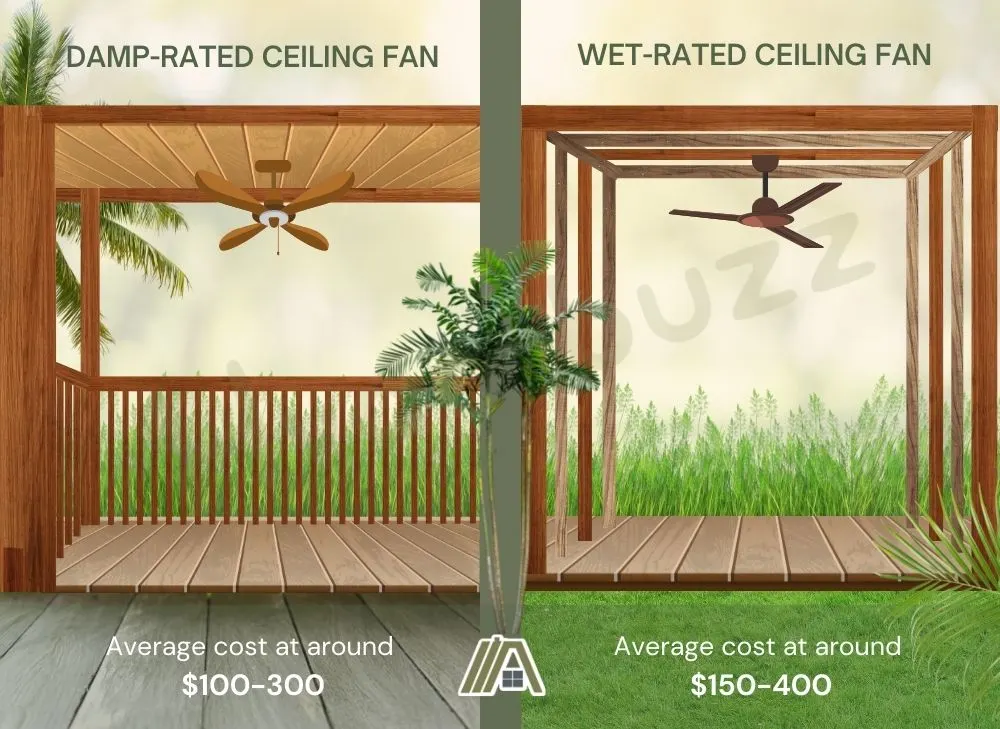
What Is an Indoor Ceiling Fan?
Indoor ceiling fans are designed for installation in completely enclosed spaces where they wouldn’t have to interact with the elements.
Indoor fans are dry-rated, meaning that they are meant to be installed in places that aren’t exposed to moisture, rain, or snow.
This even means that, although they are designed for indoor installation, they aren’t ideal for all indoor locations. For instance, dry-rated fans wouldn’t fare well in moisture-prone areas like bathrooms, laundry rooms, and steamy kitchens.
They are ideal for installation in living rooms, dens, bedrooms, foyers, workshops, dining rooms, and finished basements.
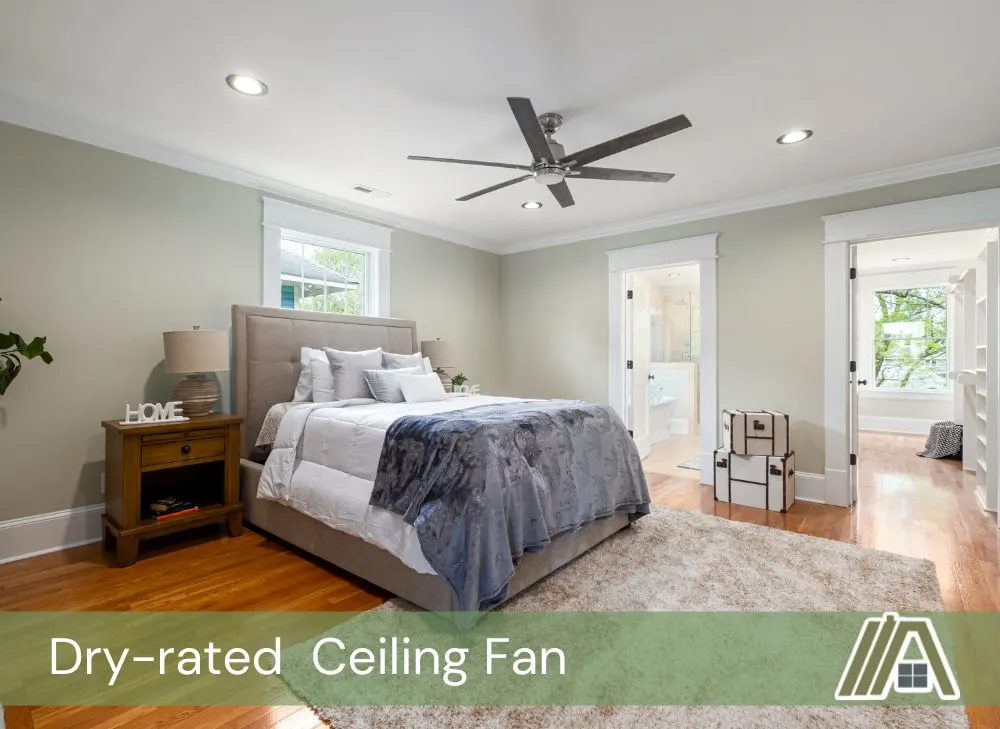
Level of Its Weather Resistance
Indoor fans are designed specifically for dry locations. They are built with quality materials, but these materials are only suitable for conditioned environments.
Because they are built for installation in enclosed locations, manufacturers do not use weather-resistant materials in constructing indoor ceiling fans.
The motor and fan components aren’t weather-sealed and aren’t capable of withstanding excessive moisture and heat. If exposed to the outdoors for a prolonged period, the metal components would start to rust or melt. Wooden blades would also swell, crack, and or warp.
The motor, which isn’t protected from moisture, would break down due to moisture buildup.
Simply put, indoor ceiling fans aren’t weather-resistant. Exposing them to the outdoors wouldn’t only cause the fans to lose their efficiency and eventually break down, but moisture damage in the electrical units could also pose a fire hazard.
Materials and Durability
Indoor fans perform extremely well as long as they aren’t installed outdoors or in a moisture-prone location.
They come in different models, so the durability of a particular fan would be dependent on the model and the particular materials used.
Most dry-rated fans have steel or stainless motor housing and their blades are made of metal, timber, or plastic.
As indoor fans do not feature weather protection and aren’t manufactured to withstand extreme temperature conditions, when compared to outdoor ceiling fans, they might be considered inferior even though they are well-suited to the indoor environment. An outdoor fan indoors would be overkill.
Installation and Airflow Efficiency Requirements
The airflow of a ceiling fan is measured in CFM (cubic feet per minute). Because Indoor ceiling fans are installed in enclosed spaces, their CFM requirement isn’t as high as that of outdoor units. On average, a room requires between 3,000-6,000 CFM to reach an acceptable cooling temperature.
With that said, the type of fan you choose should ultimately be determined by the size and layout of the room.
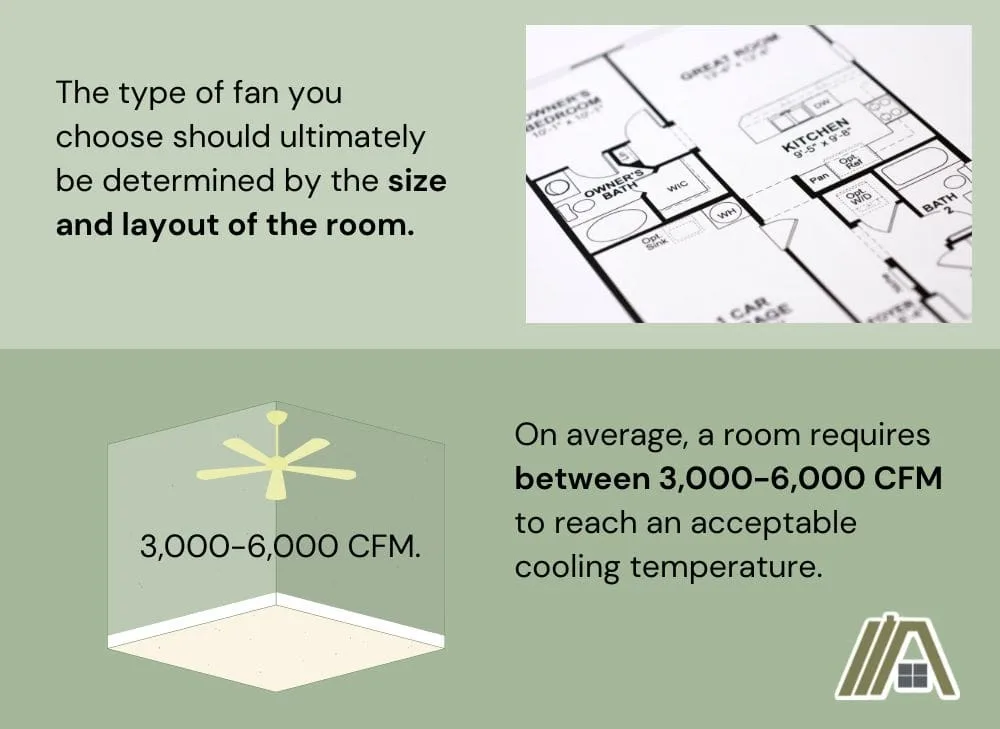
Blades and Features
Dry-rated fans are designed for indoor spaces, so special attention is usually paid to the aesthetics and design of the fan. As a result, there are various indoor ceiling fan designs on the market, making it easy to get one that blends with your decor.
Due to their installation location, dry-rated fans typically have more features and control options than outdoor fans. These days, most indoor fans also come with a lighting assembly.
Although the performance of a ceiling fan ultimately depends on its motor unit, the blades also play a role in the degree of airflow. Blade pitch is a big factor, with greater pitch being associated with greater airflow. Indoor ceiling fans are able to function competently with smaller pitches.
Four to five blades are preferable when it comes to indoor fans. Fewer blades make more noise, which is exacerbated by the enclosed, indoor space.
Indoor ceiling fans are often reversible, which can make them effective in winter and in locations like at the top of stairs.
What is Outdoor Ceiling Fan?
Outdoor ceiling fans are built to withstand moisture and weather elements. They are divided into two categories; damp-rated and wet-rated, and the installation location would determine which rating is required.
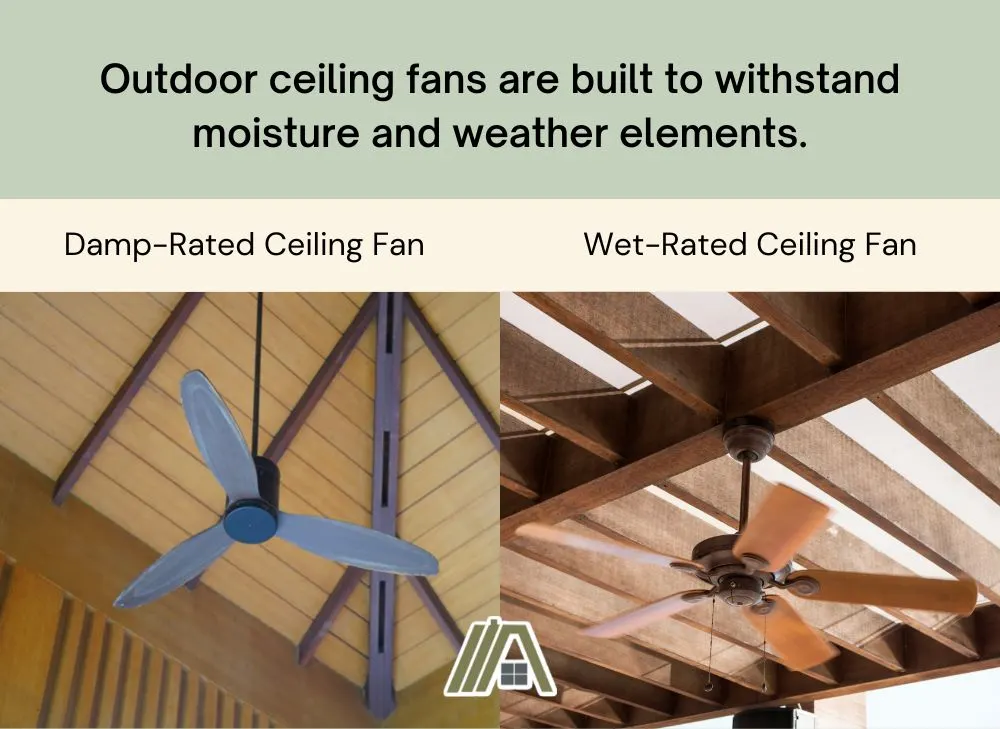
Damp-rated fans are ideal for outdoor locations that aren’t directly exposed to water, rain, or snow. Wet-rated fans are outfitted to withstand the outdoors and can survive in locations that are directly exposed to rain, snow, and extreme heat.
Outdoor fans also make great indoor fans, although, as mentioned earlier they are excessively durable. You may not want to pay for an outdoor fan when the equivalent indoor fan is all you need and it cheaper.
Level of Its Weather Resistance
The actual level of weather resistance of the fan would be dependent on its rating.
Damp-rated fans are only ideal for outdoor locations that aren’t directly exposed to the elements. This is because they are water-resistant and not waterproof. So, they can only withstand light dew and humidity. Direct exposure to snow or heavy downpour can cause damage to the fan’s components.
Examples of places you can install damp-rated fans include screened-in porches, covered patios, unfinished basements, uninsulated garages, and sunrooms. They are also great for humidity-prone indoor locations like bathrooms and laundry rooms.
Wet-rated fans are constructed with materials that can withstand winds, UV exposure, snow, and rain. The motor casing is coated with a waterproof seal that prevents moisture from coming in contact with the motor. The other fan components are made of weatherproof materials and finishing.
They are installed in gazebos, verandas, exposed porches, pergolas, and any outside location that is at risk of being exposed to the elements.
Saltwater has high corrosive elements and not all outdoor fans can handle the effects of salty air. Thus, if you live near the ocean, it’s best to use a stainless steel outdoor fan.
Materials and Durability
Outdoor ceiling fans are exposed to harsher conditions, so they are crafted with materials that are impervious to weather elements.
The commonly used materials for outdoor fans are aluminum, galvanized steel, stainless steel, and plastic. The type of plastic used is ABS plastic, which is popularly referred to as an all-weather plastic.
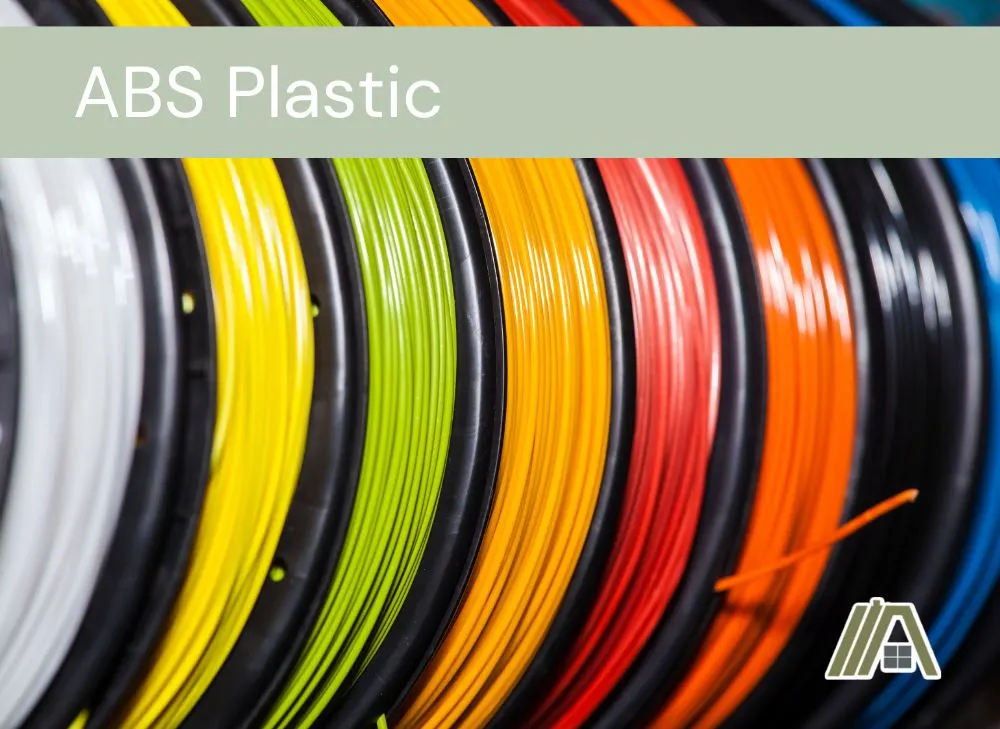
In addition to the weather-resistant materials, corrosion-resistant paint is used during finishing and the motor housing is outfitted with a weatherproof seal.
Damp- and wet-rated fans are built differently, which means that they do not fare the same way when exposed to extreme temperatures.
While damp-rated fans would warp, rust, and eventually break down after prolonged exposure to the elements, wet-rated fans would be able to live up to their service life even if they are exposed to the elements.
Outdoor fans are also made with weather-treated wood. But wood is prone to degrade over time if it is constantly exposed to moisture, so I recommend that you only use wood-bladed fans for areas that aren’t directly exposed to the elements.
Exterior fans that are made with rattan would also not last long when used in wet-rated locations.
Installation and Airflow Efficiency Requirements
Unlike indoor fans that are installed in enclosed areas, outdoor fans are installed in open spaces. This means that the atmospheric air isn’t contained within four walls. As a result, outdoor fans make use of stronger motor units.
The wiring that comes with the fan is usually rated for outdoor use but if you are using any other wiring, ensure that it is not only rated for outdoor use but that it is wet-rated if the fan is going to be exposed to the elements.
Mounting components like junction boxes should be weatherproof. You must also use screws that are rated for exterior applications, like stainless steel and silicon bronze.
Even if the installation location is the same size as that of an indoor fan, an outdoor fan demands a higher CFM. On average, outdoor spaces require between 6,000-10,000 CFMs to properly cool a space. The actual CFM required for the space would depend on its size.
Bigger spaces like a wide porch might need more than one ceiling fan for proper air circulation.
Blades and Features
Most indoor and damp-rated fans aren’t directly exposed to the elements, so they usually come with added features like a lighting kit. But because of the effect moisture has on electrical elements, wet-rated fans hardly ever come with lighting kits and sophisticated features.
Outdoor ceiling fans typically come with 2 to 7 blades. For efficient outdoor cooling, I recommend that you go for a fan with three blades. The noise associated with fewer blades is less of an issue in the outdoor space.
Cooling an open-air location requires more air movement than indoor spaces, which is why outdoor fans usually have bigger blades.
A reversible outdoor ceiling fan would not be worth the extra money because only the counterclockwise (“normal”) rotational direction would be of use outside.
Table of Differences Between Indoor and Outdoor Ceiling Fans
| Outdoor Fans | Indoor fans |
| Can be installed both indoors and outdoors | Can only be installed indoors |
| Damp-rated fans are suitable for humidity-prone locations; wet-rated fans can be installed in both damp and wet areas | Aren’t ideal for humidity or moisture-prone locations |
| Motor is encased in a weather seal | Motor isn’t weather-protected |
| They are weather-resistant | Are not weather-resistant |
| Made with sturdy, high-quality materials | Materials aren’t always as sturdy as those used for outdoor fans |
| Higher CFM requirements | Lower CFM requirements |
| Do not have as many features as indoor fans | Come with added features and control options |
| Stronger motor unit | Motor isn’t as strong as that of outdoor fans |
| Mounting components need to be waterproof | Mounting components do not have to be waterproof |
Is One Better Than The Other?
If indoor fans are installed in the right environment they can last even beyond their expected lifespan. However, when compared to outdoor fans, particularly wet-rated fans, indoor ceiling fans are no match in terms of quality and airflow.
So, if you are more concerned about the degree of airflow and the quality of the fan’s components then an outdoor fan is definitely your best bet. However, you should have in mind that outdoor fans usually cost more.
Compared to outdoor units, indoor fans have more sophisticated features and appearance. If you are more concerned about the appearance and features of a fan, then an indoor fan would be a great fit for your interior space.
With that said, indoor fans cannot replace an outdoor unit because they are not ideal for outside installation. On the other hand, an outdoor fan can easily replace any indoor fan.
You do not have much choice when it comes to cooling an outside area, making outdoor ceiling fans the champion choice in this regard.
Sources
https://www.rsandrews.com/blog/indoor-outdoor-ceiling-fans/
https://www.sescos.com/difference-between-indoor-and-outdoor-ceiling-fans/
https://harrison-electric.com/Blog/entryid/116/4-ceiling-fan-features-you-should-look-for
https://www.hansenwholesale.com/blog/ceiling-fan/key-differences-between-indoor-outdoor-fans


